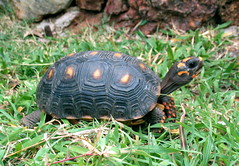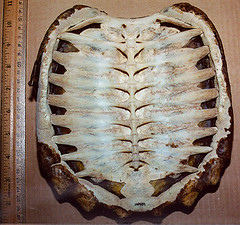M- M- M- My Chelonia

Chelonia
This is one of two tortoises who share a garden with us. He's a red-footed tortoise, so named because of the red feet. Actually, not all red-footed tortoises have red feet. Some have yellow or orange markings on their feet and legs instead. He's of the genus geochelone, "geo" because he's land dwelling, "chelone" because he's a reptile with a shell. Tortoises and turtles are the only animals with shells composed of bone (as opposed to keratin in crocodiles and armadillos or chitin in horseshoe crabs). As anyone who's ever made turtle soup can tell you (no, I haven't), a turtle's shell is not a bony box in which a soft-bodied reptile lives. It is a continuation of the animal's vertebrae and ribcage, as you can see in this photo:

The inside of a tortoise shell
(By the way, the term "tortoise" generally means chelonia that live on land, "turtle" means those that spend some or most of their time in water. The little-used "terrapin" means exclusively aquatic, except for the moonlit egg-laying forays onto the beach.) So the tortoise's shell is a neat evolutionary trick, one which gives an otherwise pretty vulnerable animal an average lifespan nearly equal to our own.
The red-footed tortoise's species is carbonaria, for the coal-like hue of its shell. They like to eat fruit, and for that they need some patience, since tree-climbing is out of the question. They also like hibiscus flowers and will eat grass when it's all they can get. Some tortoises are coprophagic. Thankfully, ours are not (or if they are, they keep that nasty habit well hidden). We know this one is probably a male by the hourglass shape of his shell. They grow to about a foot in length, so this one is probably quite young, though there is no way to accurately determine a tortoise's age (counting the scutes of the shell doesn't tell you anything). During courtship, a male red-footed tortoise will stand beside another tortoise (one he hopes is female), doing a sort of repeated double-take with his head while clucking like a hen. This apparently works for tortoises. A female red-footed tortoise usually lays about five eggs at a time, hiding them in a burrow shielded by rocks or a wall. The eggs gestate for up to a year.
The red-footed tortoise was probably brought to this island from more southern regions by the Carib, who roamed the Caribbean hundreds of years ago searching for more timid humans to shake down or eat. The tortoise made a handy portable food source for these expeditions, since it can remain alive for weeks with very little food and almost no water. Since Columbus claimed to have found this island uninhabited, perhaps the Carib had already been through before his arrival, gobbling up the local population and leaving the suddenly redundant tortoises behind. Given their life span, our friend here may be merely the tenth generation since his ancestor was left blinking on the beach while the longboats headed away with their cargo of Taino slaves/snacks.

4 Comments:
Thanks for this post! fascinating, and not at all aggravating. :)
miss you guys -dpm
This comment has been removed by a blog administrator.
This comment has been removed by a blog administrator.
This comment has been removed by a blog administrator.
Post a Comment
<< Home